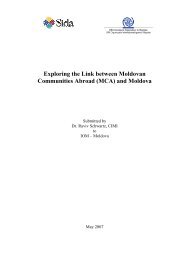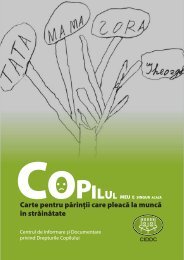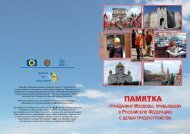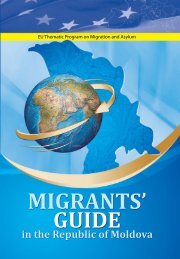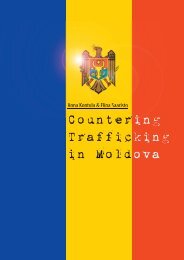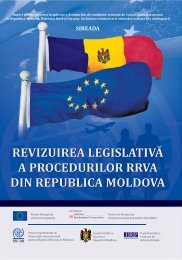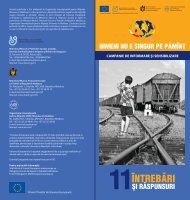Trafficking in Human Beings in Southeastern Europe - Iom
Trafficking in Human Beings in Southeastern Europe - Iom
Trafficking in Human Beings in Southeastern Europe - Iom
- No tags were found...
Create successful ePaper yourself
Turn your PDF publications into a flip-book with our unique Google optimized e-Paper software.
<strong>Traffick<strong>in</strong>g</strong> <strong>in</strong> <strong>Human</strong> Be<strong>in</strong>gs<strong>in</strong> <strong>Southeastern</strong> <strong>Europe</strong>Republic ofMoldovaIn the last two years local NGOs have been very actively <strong>in</strong>volved <strong>in</strong> preventionwork. They have received support from the US State Department, the USEmbassy, and other donors to organise <strong>in</strong>formation and awareness rais<strong>in</strong>gcampaigns. There are six NGOs directly <strong>in</strong>volved <strong>in</strong> these activities: the Associationfor Women Lawyers, CIVIS, Civic Initiative, Gender Centre, the Associationfor Youth Development and La Strada, which became active <strong>in</strong> Moldova<strong>in</strong> May 2001.NGOs have engaged <strong>in</strong> a broad range of activities: publications <strong>in</strong>clud<strong>in</strong>gbooks, magaz<strong>in</strong>es, leaflets and brochures; media campaigns; advertisementcampaigns; and documentaries about traffick<strong>in</strong>g. The Association for YouthDevelopment conducted sem<strong>in</strong>ars for young women and distributed materialsfor rais<strong>in</strong>g awareness <strong>in</strong> high schools.The Association for Women Lawyers is currently adm<strong>in</strong>ister<strong>in</strong>g a Centre for thePrevention of <strong>Traffick<strong>in</strong>g</strong> <strong>in</strong> Women. This project was launched on 15 February2001 with U.S. Government fund<strong>in</strong>g. Initially, the Centre concentrated ondevelop<strong>in</strong>g a clear strategy for a multi-media campaign. It then went on toutilise radio, television, billboards and newspapers to publicise its anti-traffick<strong>in</strong>gmessage. In addition, it publishes and distributes a monthly newsletterand brochures. It has also established and operates an anti-traffick<strong>in</strong>g telephonehotl<strong>in</strong>e <strong>in</strong> Moldova. The Centre has developed contacts, which allow itto address requests from trafficked persons or from their families to the M<strong>in</strong>istryof the Interior. The Centre now co-ord<strong>in</strong>ates local law enforcement, NGOsand <strong>in</strong>ternational organisations deal<strong>in</strong>g with traffick<strong>in</strong>g <strong>in</strong> women. It has providedupdated <strong>in</strong>formation and statistics on traffick<strong>in</strong>g to all these groups andsupported their anti-traffick<strong>in</strong>g efforts.La Strada launched a prevention and education campaign <strong>in</strong> mid-2001,through sem<strong>in</strong>ars for groups at risk <strong>in</strong> educational <strong>in</strong>stitutions throughoutMoldova, <strong>in</strong>clud<strong>in</strong>g board<strong>in</strong>g schools, orphanages, high schools and technicalschools. Presently, La Strada is negotiat<strong>in</strong>g with the M<strong>in</strong>istry of Education forapproval and support for a programme of extracurricular education and preventionsem<strong>in</strong>ars <strong>in</strong> educational <strong>in</strong>stitutions. Sem<strong>in</strong>ars on traffick<strong>in</strong>g for schoolstaff are also conducted. To ensure the cont<strong>in</strong>uity and effectiveness of the preventioncampaign, La Strada is creat<strong>in</strong>g a network of local NGOs.Other activities planned by La Strada and other NGOs <strong>in</strong>clude:• Collect<strong>in</strong>g materials about traffick<strong>in</strong>g and anti-traffick<strong>in</strong>g <strong>in</strong>itiatives;• “Women on Labour Market” project – creat<strong>in</strong>g jobs for women andalso for trafficked persons;• “<strong>Human</strong> Rights of Women” sem<strong>in</strong>ars provid<strong>in</strong>g general <strong>in</strong>formationabout women’s rights and <strong>in</strong>formation about traffick<strong>in</strong>g;• Consult<strong>in</strong>g and support<strong>in</strong>g a number of foreign TV stations prepar<strong>in</strong>gdocumentaries about traffick<strong>in</strong>g;• Prepar<strong>in</strong>g a database of organisations work<strong>in</strong>g on traffick<strong>in</strong>g;.• Publish<strong>in</strong>g educational materials on the issue of traffick<strong>in</strong>g;• Organis<strong>in</strong>g round tables with NGOs on prevention and social assistance.32Between 1999 – 2001, the International NGO W<strong>in</strong>rock International, ran aprogramme of:• Research - comprehensive research on the prevalence and patternsof domestic violence and traffick<strong>in</strong>g <strong>in</strong> women, and the relevant legislation,regulations, procedures <strong>in</strong> its four project countries;• Tra<strong>in</strong><strong>in</strong>g Design and Implementation - capacity build<strong>in</strong>g for NGOs toenhance their ability to tra<strong>in</strong> multi-discipl<strong>in</strong>ary community audiences,and become long-term monitors of the crim<strong>in</strong>al justice system; and



